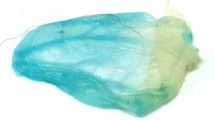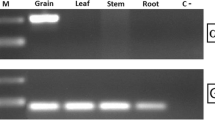Abstract
Cowpea is one of the important grain legumes. Storage pests, Callosobruchus maculatus and C. chinensis cause severe damage to the cowpea seeds during storage. We employ a highly efficient Agrobacterium-mediated cowpea transformation method for introduction of the bean (Phaseolus vulgaris) α-amylase inhibitor-1 (αAI-1) gene into a commercially important Indian cowpea cultivar, Pusa Komal and generated fertile transgenic plants. The use of constitutive expression of additional vir genes in resident pSB1 vector in Agrobacterium strain LBA4404, thiol compounds during cocultivation and a geneticin based selection system resulted in twofold increase in stable transformation frequency. Expression of αAI-1 gene under bean phytohemagglutinin promoter results in accumulation of αAI-1 in transgenic seeds. The transgenic protein was active as an inhibitor of porcine α-amylase in vitro. Transgenic cowpeas expressing αAI-1 strongly inhibited the development of C. maculatus and C. chinensis in insect bioassays.




Similar content being viewed by others
References
Abrol DP (1999) Pulse susceptibility to Callosobruchus chinensis (L) (Bruchidae: Coleoptera) under field conditions. Trop Agric 76:150
Altabella T, Chrispeels MJ (1990) Tobacco plants transformed with the bean αAI gene express an inhibitor of insect α-amylase in their seeds. Plant Physiol 93:805–810
An G, Evert PR, Mitra A, Ha SB (1988) In: Gelvin SB, Schilperoot RA (eds) Plant molecular biology manual. Kluwer, Dordrecht, pp 1–19
Bernfeld P (1955) Amylases a and b. Meth Enzymol 1:149–154
Bevan M (1984) Binary Agrobacterium vector for plant transformation. Nucl Acids Res 12:8711–8721
Bradford MM (1976) A rapid and sensitive method for the quantitation of microgram quantities of protein using the principle of protein-dye binding. Anal Biochem 72:248–254
Chaudhury D, Madanpotra S, Jaiwal R, Saini R, Kumar PA, Jaiwal PK (2007) Agrobacterium tumefaciens-mediated high frequency genetic transformation of an Indian cowpea (Vigna unguiculata L. Walp.) cultivar and transmission of transgenes into progeny. Plant Sci 172:692–700
Chilton MD, Currier TC, Farrand SK, Bendich AJ, Gordon MP, Nester EW (1974) Agrobacterium tumefaciens DNA and PS8 bacteriophage DNA not detected in crown gall tumors. Proc Natl Acad Sci USA 71:3672–3676
Fatokun CA (2002) Breeding cowpea for resistance to insect pests: attempted crosses between cowpea and V. vexillata. In: Fatokun CA, Tarawali SA, Singh BB, Kormawa PM, Tamo M (eds) Challenges and opportunities for enhancing sustainable cowpea production. Proceedings of the world cowpea conference III, held at the International Institute of Tropical Agriculture, IITA, Ibadan Nigeria 4–8 2000 IITA, Ibadan, Nigeria
Gamborg O, Miller R, Ojima K (1968) Nutrient requirements of suspension cultures of soybean root cells. Exp Cell Res 50:151–158
Hansen G, Das A, Chilton MD (1994) Constitutive expression of the virulence genes improves the efficiency of plant transformation by Agrobacterium. Proc Natl Acad Sci USA 91:7603–7607
Hiei Y, Ohta S, Toshihiro K, Komari T (1994) Efficient transformation of rice (Oryza sativa L.) mediated by Agrobacterium and sequence analysis of the boundaries of the T-DNA. Plant J 6:271–282
Hoekema A, Hirsch PR, Hooykaas PJJ, Schilperoort RA (1983) A binary plant vector strategy based on separation of vir- and T-region of the Agrobacterium tumefaciens Ti-plasmid. Nature 303:179–180
Ignacimuthu S, Prakash S (2006) Agrobacterium-mediated transformation of chickpea with α-amylase inhibitor gene for insect resistance. J Biosci 31:339–345
Ishimoto M, Sato T, Chrispeels MJ, Kitamura K (1996) Bruchid resistance of transgenic azuki bean expressing seeds α-amylase inhibitor of the common bean. Entomol Exp Appl 79:309–315
Ishimoto M, Yamada T, Kaga A (1999) Insecticidal activity of an α-amylase inhibitor-like protein resembling a putative precursor of α-amylase inhibitor in the common bean, Phaseolus vulgaris L. Biochim Biophys Acta 1432:104–112
Jefferson RA (1987) Assaying chimearic genes in plants: the GUS gene fusion system. Plant Mol Biol 204:387–405
Langyintuo A, Lowenberg-DeBoer J, Faye M, Lambert D, Ibro G, Moussa B, Kergna A, Kushwaha S, Musa S, Ntoukam G (2003) Cowpea supply and demand in West and Central Africa. Field Crops Res 82:215–231
Machuka J (2002) Potential role of transgenic approaches in the control of cowpea insect pests. In: Fatokun CA, Tarawali SA, Singh BB, Kormawa PM, Tamò M (eds) Challenges and opportunities for enhancing sustainable cowpea production. Proceedings of the World cowpea conference III held at the International Institute of Tropical Agriculture (IITA), Ibadan, Nigeria, 4–8 September 2000. IITA, Ibadan, Nigeria
Morton RL, Schroeder HE, Bateman KS, Chrispeels MJ, Armstrong E, Higgins TJV (2000) Bean α-amylase inhibitor 1 in transgenic peas (Pisum sativum) provides complete protection from pea weevil (Bruchus pisorum) under field conditions. Proc Natl Acad Sci USA 97:3820–3825
Murashige T, Skoog F (1962) A revised medium for rapid growth and bioassay with tobacco tissue cultures. Physiol Plant 15:473–497
Olhoft PM, Lin K, Galbraith J, Nielsen NC, Somers DA (2001) The role of thiol compounds in increasing Agrobacterium-mediated transformation of soybean cotyledonary-node cells. Plant Cell Rep 20:731–737
Park SH, Lee BM, Salas MG, Srivatanakul M, Smith RH (2000) Shorter T-DNA or additional virulence genes improve Agrobacterium-mediated transformation. Theor Appl Genet 101:1015–1020
Popelka C, Gollasch S, Moore A, Molvig L, Higgins TJV (2006) Genetic transformation of cowpea (Vigna unguiculata L.) and stable transmission of the transgenes to progeny. Plant Cell Rep 25:304–312
Rogers SO, Bendich AJ (1988) In: Gelvin SB, Schilperoort RA (eds) Plant molecular biology manual. A6 1–10.. Kluwer, Netherlands
Sahoo L, Sushma, Sugla T, Singh ND, Jaiwal PK (2000) In vitro plant regeneration and recovery of cowpea (Vigna unguiculata) transformants via Agrobacterium-mediated transformation. Plant Cell Biotech Mol Biol 1(1&2):47–54
Sahoo L, Sugla T, Jaiwal PK (2003) In vitro regeneration and transformation of cowpea, mungbean, urdbean and azukibean. In: Biotechnology for the improvement of legumes Part-B, pp 89–120, Kluwer, Netherlands
Sambrook J, Fritsch EF, Maniatis T (1989) Molecular cloning: a laboratory manual, 2nd edn. Cold Spring Harbor Laboratory Press, New York
Sarmah BK, Moore A, Tate W, Molvig L, Morton RL, Rees DP, Chiaiese P, Chrispeels MJ, Tabe LM, Higgins TJV (2004) Transgenic chickpea seeds expressing high levels of a bean α-amylase inhibitor. Mol Breed 14:73–82
Schroeder HE, Gollash S, Moore A (1995) Bean α-amylase inhibitor confers resistance to the pea weevil (Bruchus pisorum) in transgenic peas (Pisum sativum L.). Plant Physiol 107:1233–1239
Shade RE, Schroeder RE, Poueyo JJ, Tabe LM, Murdock LI, Higgins TJV, Chrispeels MJ (1994) Transgenic pea seeds expressing the α-amylase inhibitor of the common bean are resistant to bruchid beetles. Biotchnology 12:793–796
Singh BB, Ehlers JD, Sharma B, Freire Filho FR (2000) Recent progress in cowpea breeding. In: Proceedings of world cowpea conference III, 4–7 September 2000. IITA, Ibadan, Nigeria, pp 22–40
Sousa-majer MJD, Hardie DC, Turner NC, Higgins TJV (2007) Bean á-Amylase inhibitors in transgenic peas inhibit development of pea weevil larvae. J Econ Entomol 100:1416–1422
Tarver MR, Shade RE, Shukle RH, Moar WJ, Muir WM, Murdock LM, Pittendrigh BR (2007) Pyramiding of insecticidal compounds for control of the cowpea bruchid (Callosobruchus maculatus F.). Pest Manag Sci 63:440–446
Van der Fits L, Deakin EA, Hoge JHC, Memelink J (2000) The ternary transformation system: constitutive virG on a compatible plasmid dramatically increases Agrobacterium-mediated plant transformation. Plant Mol Biol 43:495–502
Wu H, Doherty A, Jones HD (2007) Efficient and rapid Agrobacterium-mediated genetic transformation of durum wheat (Triticum turgidum L. var. durum) using additional virulence genes. Transgenic Res 17:425–436
Acknowledgments
We thank Commonwealth Scientific and Industrial Research Organization (CSIRO), Australia for providing the pTA3 (αAI-1 construct), Dr. T. J. V. Higgins, CSIRO Plant Industry, Australia, for his valuable suggestions and Prof. P. B. Kirti, University of Hyderabad, India for his generous technical assistance. We thank Dr. Toshihiko Komari, Japan Tobacco, Inc., Japan, for providing pSB1, Prof. K. Veluthambi, MKU, Madurai, India for the Agrobacterium strains and to the Center for Application of Molecular Biology to International Agriculture (CAMBIA), Australia for plasmid pCAMBIA2301. This work was funded by the Department of Biotechnology, Government of India. SKS and SB are grateful to Indian Institute of Technology Guwahati for a doctoral fellowship.
Author information
Authors and Affiliations
Corresponding author
Additional information
Communicated by R. Rose.
Rights and permissions
About this article
Cite this article
Solleti, S.K., Bakshi, S., Purkayastha, J. et al. Transgenic cowpea (Vigna unguiculata) seeds expressing a bean α-amylase inhibitor 1 confer resistance to storage pests, bruchid beetles. Plant Cell Rep 27, 1841–1850 (2008). https://doi.org/10.1007/s00299-008-0606-x
Received:
Accepted:
Published:
Issue Date:
DOI: https://doi.org/10.1007/s00299-008-0606-x




